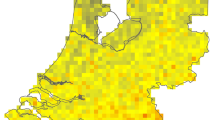Abstract
Objectives
To detail the use of a model to predict areas of low, medium, and high risk of West Nile virus (WNV) in humans in both 2003 and 2007 in the province of Saskatchewan. To identify consistent high-risk areas from year to year as well as important environmental variables within those high-risk areas.
Methods
The number of laboratory-confirmed WNV individuals was obtained from Saskatchewan Health by rural municipality. The population at risk was obtained from Statistics Canada by rural municipality. Climate and habitat variables were incorporated into a discriminant analysis model with the production of risk maps as an end product.
Results
The discriminant analysis models had testing classification accuracies of 67% in 2003 and 44% in 2007. Climate and habitat variables remained important in all models while some habitat variables were less important in 2007. Risk maps from historically trained 2007 model revealed a southwest to northeast decreasing trend of risk.
Conclusion
The models could be useful for indicating areas of high risk on a year-to-year basis or based on historical data. High-risk regions are characterized by less rainfall in June and July followed by higher temperatures in July and August with less vegetation and water coverage than low-risk regions.
Résumé
Objectifs
Expliquer l’utilisation d’un modèle de prévision des secteurs à risque modéré, moyen et élevé pour les humains de contracter le virus du Nil occidental (VNO) en 2003 et en 2007 dans la province de la Saskatchewan. Déterminer les secteurs à risque uniformément élevé d’une année à l’autre, ainsi que les variables environnementales importantes dans les secteurs à risque élevé.
Méthode
Nous avons obtenu auprès du ministère de la Santé de la Saskatchewan le nombre de cas séropositifs pour le VNO confirmés en laboratoire, par municipalité rurale. Statistique Canada nous a fourni le nombre de personnes à risque par municipalité rurale. Des variables climatiques et d’habitat ont été intégrées dans un modèle d’analyse discriminante afin de produire des cartes du risque.
Résultats
Les modèles d’analyse discriminante étaient exacts à 67 % en 2003 et à 44 % en 2007. Les variables climatiques et d’habitat sont demeurées importantes dans tous les modèles, mais certaines variables d’habitat avaient moins d’importance en 2007. Les cartes du risque produites à partir du modèle chronologique de 2007 montrent que le risque a eu tendance à diminuer en allant du Sud-Ouest vers le Nord-Est.
Conclusion
Ces modèles pourraient être utiles pour indiquer les secteurs à risque élevé d’une année à l’autre ou selon des données historiques. Les régions à risque élevé se caractérisent par une pluviosité relativement faible en juin et en juillet suivie de hausses de la température en juillet et en août, avec une couverture végétale et hydrique plus limitée que dans les régions à risque modéré.
Similar content being viewed by others
References
Rogers DJ, Myers MF, Tucker CJ, Smith PF, White DJ, Backenson B, et al. Predicting the distribution of West Nile fever in North America using satellite sensor data. PE&RS 2002;68:112–14.
Brooker S, Hay SI, Bundy DAP. Tools from ecology: Useful for evaluating infection risk models? Trends in Parasitology 2002;18:70–74.
Kitron U. Risk maps: Transmission and burden of vector-borne diseases. Par-asitology Today 2000;16:324–25.
Beck LR, Lobitz BM, Wood BL. Remote sensing and human health: New sensors and new opportunities. Emerg Infect Dis 2000;6:217–26.
Rogers DJ, Randolph SE, Snow RW, Hay SI. Satellite imagery in the study and forecast of malaria. Nature 2002;415:710–18.
Hay SI, Tucker CJ, Rogers DJ, Packer MJ. Remotely sensed surrogates of meteorological data for the study of the distribution and abundance of arthropod vectors of disease. Ann Trop Med Hyg 1996;90:1–19.
Mellor PS, Leake CJ. Climatic and geographic influences on arboviral infections and vectors. Rev Sci Tech Off Int Epiz 2000;19:41–54.
Curry P. Saskatchewan mosquitoes and West Nile virus. Blue Jay 2004;62:104–11.
Rainham DGC. Ecological complexity and West Nile virus: Perspectives on improving public health response. Can J Public Health 2005;96:37–40.
Epp T. West Nile Virus: From Surveillance to Prediction Using Saskatchewan Horses [thesis]. Saskatoon, SK: University of Saskatchewan, 2007. Available online at: https://doi.org/library2.usask.ca/theses/available/etd-08012007-160845/ (Accessed April 1, 2009).
Dohoo I, Martin W, Stryhn H. Veterinary Epidemiologic Research, 1st ed. Char-lottetown, PE: AVC Inc., 2003;322.
Waller LA, Gotway CA. Applied Spatial Statistics for Public Health Data, 1st ed. Hoboken, NJ: John Wiley & Sons, Inc., 2004;494.
Jensen JR. Introductory Digital Image Processing, 3rd ed. Upper Saddle River, NJ: Pearson Prentice Hall, 2005;311–19.
Klecka WR. Discriminant Analysis. Sage University Papers, Series on Quantitative Application in the Social Sciences, 07-019. Beverly Hills, CA: Sage Publications, 1980;1–71.
Shaman J, Day JF. Achieving operational hydrologic monitoring of mosquito-borne disease. Emerg Infect Dis 2005;11:1343–50.
Author information
Authors and Affiliations
Corresponding author
Rights and permissions
About this article
Cite this article
Epp, T.Y., Waldner, C.L. & Berke, O. Predicting Geographical Human Risk of West Nile Virus–Saskatchewan, 2003 and 2007. Can J Public Health 100, 344–348 (2009). https://doi.org/10.1007/BF03405266
Received:
Accepted:
Published:
Issue Date:
DOI: https://doi.org/10.1007/BF03405266




